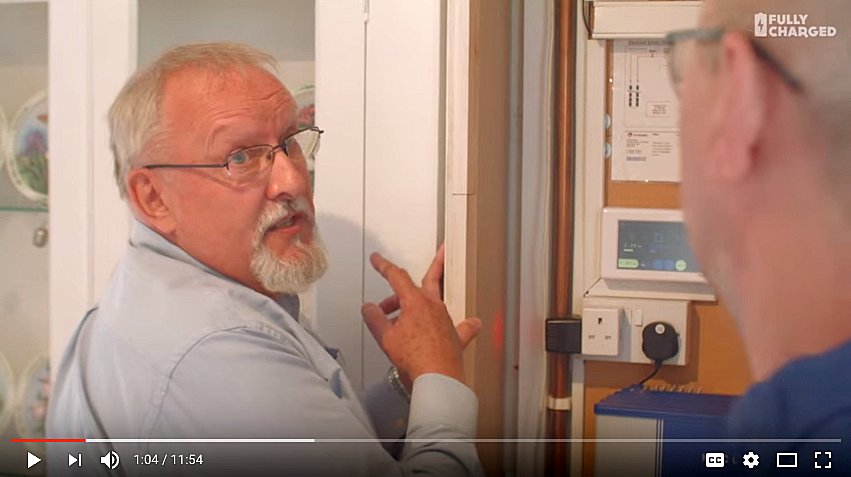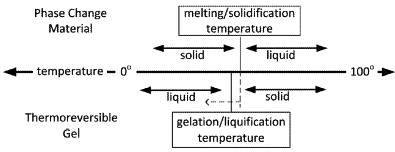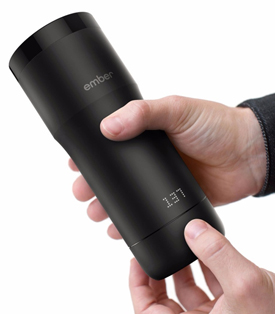 The Phase Change Matters e-mail newsletter is a weekly summary of the latest news and research on phase change materials and thermal energy storage. To subscribe, visit www.puretemp.com/subscribe. For more frequent updates, follow @puretemp on Twitter or visit the Phase Change Matters blog, www.puretemp.com/pcmatters.
The Phase Change Matters e-mail newsletter is a weekly summary of the latest news and research on phase change materials and thermal energy storage. To subscribe, visit www.puretemp.com/subscribe. For more frequent updates, follow @puretemp on Twitter or visit the Phase Change Matters blog, www.puretemp.com/pcmatters.
ENERGY STORAGE

Video blog takes an engaging look at SunampPV system
Sunamp‘s PCM “heat battery” system is featured in the latest episode of “Fully Charged,” a video blog hosted by the British actor, comedian and writer Robert Llewellyn.
The lively YouTube series highlights the latest developments in renewable energy. In the new episode, Sunamp employee Andy Trewin, above, explains how the system installed at his home in Bristol, England, works.
The 5-kilowatt SunampPV battery stores excess energy collected by rooftop solar panels and releases heat on demand for hot water and central heating. Trewin says the system has reduced his gas bill by 75 percent since it was installed last year.
“I started off with one SunampPV battery, and I’m now experimenting with two to make more use of the excess energy produced,” Trewin says in the clip. “The battery links through to the back of the boiler and when I switch on the tap cold mains water flows through the battery and instantly heats up to 58 degrees. A blending valve cools it to a comfort level, giving us hot water on demand using solar energy.”
For more on Trewin’s home system, see: http://wattson.energyhive.com/dashboard/AndyT.
AWARDS
EPA accepting nominations for 2017 Green Chemistry Challenge Awards
The U.S. Environmental Protection Agency is accepting nominations for the 2017 Presidential Green Chemistry Challenge Awards. Companies or institutions that have developed a process or product that better protects public health and the environment are eligible.
Nominations will be accepted through Dec. 31, 2016. There is no entry fee. There are six award categories this year:
• Greener Synthetic Pathways• Greener Reaction Conditions
• The Design of Greener Chemicals
• Small Business
• Academic
• Specific Environmental Benefit: Climate Change
Since the program began 21 years ago, the EPA has received more than 1700 nominations and presented awards to developers of 109 technologies. Dr. William R. Sutterlin, chief science officer at Entropy Solutions, was a member of a University of Missouri team that won the academic award in 2006 for developing an inexpensive method to convert waste glycerin, a byproduct of biodiesel fuel production, into propylene glycol.
PATENTS
Thermostatic materials, methods of making and uses thereof

U.S. patent application 20160304761 (applicant Empire Technology Development LLC, Wilmington, De.):
“Thermostatic materials and methods for making and using the materials are disclosed. The thermostatic materials have phase change materials (PCMs) incorporated into a composite with thermoreversible gels (TRGs) that undergo gelation prior to the melt temperature of the PCMs so that at temperatures at which the PCMs become liquid, the liquid PCM is retained by the gel, and at temperatures at which the gel becomes liquid, the liquid form of the gel is retained by a solid form of the PCM.”
Aliphatic materials and uses thereof in heating and cooling applications
U.S. patent application 20160305716 (applicant Elevance Renewable Sciences Inc., Woodridge, Ill.):
“Aliphatic materials and their use in passive heating and cooling applications are generally disclosed. In some embodiments, dibasic acids and esters (diesters) thereof and their use in passive heating and cooling applications are disclosed. In some embodiments, C18 dibasic acids and esters thereof are disclosed, including their use in passive heating and cooling applications. In some embodiments, various olefins, including alkenes and olefinic acids and esters, are disclosed, including their use in passive heating and cooling applications. … [T]he disclosure also provides passive heating and cooling compositions that comprise one or more phase-change compounds selected from the group consisting of: 9-octadecene, octadecanes, pentadecanes, tridecanes, methyl tridecanoate, and methyl pentadecanoate.”
IN BRIEF
• Siemens says its packed-bed thermal storage concept for wind power could deliver energy at well below 0.10 euros per kilowatt-hour. The system uses surplus electricity to blow air at 600 degrees Celsius across a packed bed of basalt rocks in an insulated container.
• The National Law Review takes a detailed look at the impact of the newly revised Toxic Substances Control Act on chemical importers, noting that “companies planning to ship chemical-based products to the United States should have a basic understanding of the TSCA.”
• Researchers from the Universidad Politécnica de Madrid have invented a new thermal energy storage system that uses molten silicon to store up to 10 times more energy than existing storage devices. “The proposed new thermal energy storage system,” according to a report in New Atlas, “involves heating the silicon in a container using either concentrated sunlight on surplus electricity generated by renewable power. The molten silicon – which can reach temperatures of around 1,400° C (2,552° F) – can be isolated from its environment until energy is needed, at which point the heat is converted to electricity.”
• SolarReserve has proposed building the world’s largest solar power plant in Nevada. The 2-gigawatt Sandstone project would include up to 10 concentrated solar arrays, each equipped with a molten salt thermal storage system.
• SUNCNIM has raised 60 million euros to help finance construction of the world’s first commercial Fresnel concentrated solar power plant with energy storage. The plant in the French Pyrenees will have four hours of thermal storage capacity. The thermal energy will be converted into electricity by a steam generation process.
 • Ember Technologies, which raised more than $350,000 on IndieGoGo last year to develop a temperature-adjustable mug, sent backers another update this week: “We are happy to announce that shipping will begin the first week of November for our pre-order customers.” The $150 mug uses bio-based phase change material and a microprocessor-controlled heating system to maintain hot beverages at temperatures set by the user.
• Ember Technologies, which raised more than $350,000 on IndieGoGo last year to develop a temperature-adjustable mug, sent backers another update this week: “We are happy to announce that shipping will begin the first week of November for our pre-order customers.” The $150 mug uses bio-based phase change material and a microprocessor-controlled heating system to maintain hot beverages at temperatures set by the user.
• Ministry, whose high-tech clothing line includes dress shirts infused with phase change material, has opened a store in downtown Chicago.
• The American Society of Interior Designers has opened a Material ConneXion library at the society’s new corporate headquarters in Washington, D.C. The Materials ConneXion database lists more than 7,500 “unique, innovative and sustainable materials.” PureTemp’s biobased phase change materials were added to database last year.
• New from Market Research Engine: “Global Microencapsulation Market Research Report – Industry Analysis, Size, Share, Growth, Trends and Forecast, 2014 – 2021.” The report projects the market will reach $8.5 billion by 2021, a compound annual growth rate of 8 percent.
• In a guest column for Outsourced Pharma, Kevin Lawler of Pelican BioThermal outlines “three reasons bulk freight forwarding and life science are turning to passive for cold chain.”
• Alexium International has announced sales agreements to supply its phase change cooling technology (Alexicool) to two unidentified mattress fabric producers based in the United States. The company says the three-year deals will generate $3 million in revenue per year.
RESEARCH ROUNDUP
For our full list of recent academic research, see puretemp.com/academic. Here are highlights from the past week:
From International Journal of Heat and Mass Transfer:• Correction of the enthalpy–temperature curve of phase change materials obtained from the T-History method based on a transient heat conduction model
From Energy Procedia:
• Modeling of Building Envelope’s Thermal Properties by Applying Phase Change Materials
• Modeling of Phase Change in Spheres for Applications in Solar Thermal Heat Storage Systems
From International Journal of Refrigeration:
• Phase change dispersion properties, modelling apparent heat capacity
From Applied Energy:
• Form-stable phase change materials with high phase change enthalpy from the composite of paraffin and cross-linking phase change structure
From Chemical Engineering Science:
• Rheological study of CO2 hydrate slurry in the presence of Sodium Dodecyl Sulfate in a secondary refrigeration loop
From Applied Ergonomics:
• Physiological and perceptual effects of a cooling garment during simulated industrial work in the heat
From Applied Thermal Engineering:
• Transient behavior analysis of the melting of nanoparticle-enhanced phase change material inside a rectangular latent heat storage unit
• Enhanced thermal conductivity of phase change nanocomposite in solid and liquid state with various carbon nano inclusions
NETWORKING
Connect with PCM experts and industry leaders on LinkedIn
More than 900 of your peers have joined a LinkedIn group devoted to the discussion of phase change material and thermal energy storage. The Phase Change Matters group is an interactive complement to the award-winning blog and newsletter of the same name.
You are invited to join the group and connect with PCM and TES experts from around the world. New members this week include Matan Feldman, aerospace engineer, Israel; Gerard Ferrer Muñoz, Ph.D. candidate at GREA, University of Lleida, Spain; Christina Konstantinidou, Ph.D. candidate at Aristotle University of Thessaloniki, Greece; and Shin Kishioka, president, ITA Inc., Chicago.